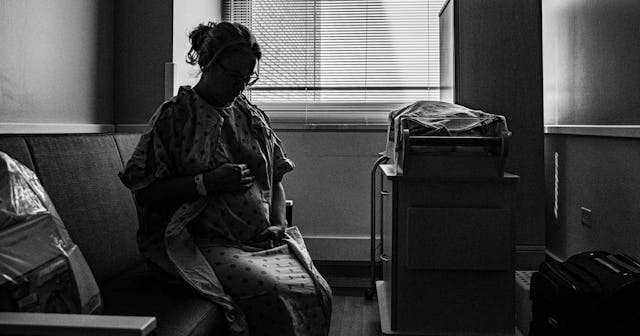Preeclampsia Can Happen After Birth Too

If you’re a parent, you’ve likely heard of the serious pregnancy condition called preeclampsia. If you’ve been pregnant, your doctor or midwife probably peppered you with questions regarding preeclampsia symptoms, such as excess swelling, headaches, and blurry vision. You probably had your blood pressure checked multiple times to make sure it wasn’t too high (a telltale symptom of preeclampsia) and had your urine for protein (another symptom of the disorder).
If you were diagnosed with preeclampsia, your pregnancy was doubtless heavily monitored, which makes sense, because if untreated preeclampsia can result in the shutdown of your major organs, and even death. You may have even had to deliver before your due date to save your and your baby’s lives. Like the majority of women, your symptoms were probably much better after giving birth, a huge and necessary relief.
But what most of us don’t know is that preeclampsia isn’t just a medical condition that happens during pregnancy. According to the Cleveland Clinic, it can happen up to six weeks after you’ve had a baby. And the scary thing is that most women don’t know this, most healthcare providers don’t alert them of this fact, and most women don’t even visit their doctors until six weeks postpartum.
Unsplash
When preeclampsia happens in the postpartum period, it usually occurs within 48 hours of childbirth, notes the Cleveland Clinic, but as The New York Times reports, the condition can strike perfectly healthy, low-risk women – women who don’t have a history of preeclampsia, and who have just had healthy pregnancies and given birth to healthy babies.
This would have been me. I was lucky to have two totally low-risk pregnancies and 100% healthy babies. To think that something this dangerous could have crept up on me without warning is absolutely terrifying.
The Times shared the story of Lauren Lowrey, a 34 year-old mom who’d given birth to her second baby five days prior. She’d had a normal pregnancy and birth, and a normal postpartum period. But that morning, something was off.
“I just didn’t feel right,” Lowrey said, describing sudden and deep exhaustion, along with a headache and backache that didn’t get better even after taking painkillers. The following day, she had trouble catching her breath, and her heart was beating irregularly and noticeably slowly.
“I was exhausted, but now I was afraid to close my eyes,” Lowrey told the Times. “I remember thinking, ‘If I go to sleep, I might not wake up again.’”
rawpixel.com/Pexels
Thankfully, Lowrey called her doctor right away, and was rushed to the hospital. She was promptly diagnosed with postpartum preeclampsia, was treated, and was fine in the end. However, she was told that without prompt treatment, she may have suffered a life-threatening seizure or stroke.
Postpartum preeclampsia is rare, which is a good thing. But overall, cases of preeclampsia have been rising over the past 30 years, according to The National Institute of Health. And while most instances of preeclampsia happen during pregnancy and are treated then, when preeclampsia happens postpartum, the symptoms can be more serious, according to the Times.
Part of this might be simply that postpartum women aren’t aware that preeclampsia could be a thing after they’ve had a baby. And especially if they had healthy pregnancies, their healthcare providers may become complacent. According to Eleni Tsigas, C.E.O. of the Preeclampsia Foundation, many healthcare providers themselves don’t even realize how prevalent postpartum preeclampsia is.
This lack of knowledge “impacts the entire health care team, from doctors to nurses to midwives,” Tsigas tells the Times. “They mentally relax after delivery,” Tsigas added. “They lose sight of the surveillance and care that many women continue to require.”
Of course, not all doctors or midwives lack this knowledge – there are some amazing providers out there. But with preventable postpartum deaths in America rising at alarming rates – disproportionately impacting women of color – this is an issue that must be on all of our radars, and systems need to be in place so that postpartum women receive the compassionate and thorough care they deserve.
We also should be lobbying all healthcare providers to check in or schedule visits with moms well before the 6-week postpartum visit. There are so many issues that come up for moms in those six weeks, from physical health to mental health, and it would be so helpful for new moms to have an extra check-in. The American College of Obstetrics and Gynecologists (ACOG) has recently recommended doctors see moms sooner than six weeks, and let’s hope that change is implemented ASAP.
Again, something like postpartum preeclampsia is relatively rare, but it can happen, and more of us need to know this. Symptoms you should be aware of, according to the Cleveland Clinic, include severe headache; unusual swelling of hands, feet, or face; nausea; vomiting; blurry vision or other vision changes; abdominal pain; and sudden weight gain.
Really, if you have any concerns at all about your wellbeing after having a baby, don’t hesitate for one second to reach out to your healthcare provider, or go right to the emergency room. In these instances, it’s always better to be safe than sorry.
This article was originally published on